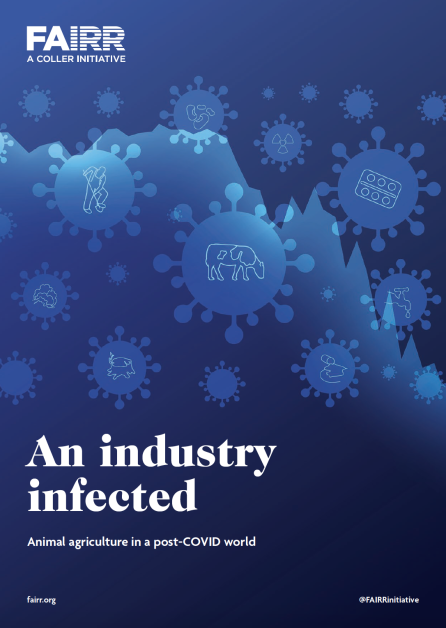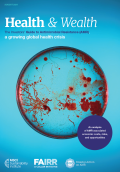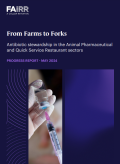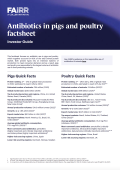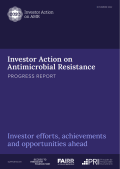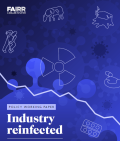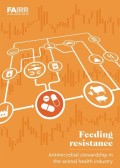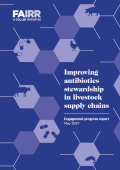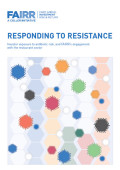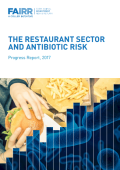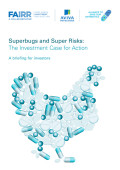Introduction
This FAIRR report aims to provide investors with insights into the financially material impacts of the current crisis on the animal protein sector, and highlights the risks that the industry faces due to its potential to foster future pandemics.
As the COVID-19 pandemic unfolds globally, we are presented with a real-time case study into the vulnerability of animal agriculture systems to external shocks. It has reminded us of the vulnerability of human health to disease risks stemming from both wild and domestic animals, and has served as a warning of the role modern animal production systems can play in increasing zoonotic disease risk.
In this report, we have created a Pandemic Ranking, by adjusting our existing 2019 Coller FAIRR Protein Producer Index to consider only those ESG risk factors relevant to this topic.
Animal Agriculture's Exposure to Global Shocks
A monumental and coordinated shift in biosecurity training, safety and surveillance is needed, especially in emerging markets.
Meat processing plants are at the centre of COVID-19 outbreaks worldwide. Meat industry workers across the world have been disproportionately impacted by COVID-19, with over 20,000 workers in the US alone contracting the virus to date. Slaughterhouses and processing facilities have been forced to close or reduce capacity in response to labour shortages and social distancing requirements. This pattern of disruption within animal protein supply chains has been repeated globally, revealing key bottlenecks within these systems and their inherent fragility to external shocks.
The industrialised model of animal production has been optimised to prioritise both cost and production efficiency, at the expense of multiple other factors including worker safety, biosecurity and ultimately, resilience. In many developed markets, this has been exacerbated by decades of industry consolidation. Meat plant closures left the US pork slaughtering capacity down 50% in early May. With access to the market reduced or even removed entirely, producers are left with few options. We are witnessing the mass culling of livestock by producers who cannot afford to maintain them, while some consumers and manufacturers are left facing shortages.
As a disease that affects humans, COVID-19 has impacted the animal protein industry predominantly through its reliance on labour. However, the industry is also vulnerable to disease risks within livestock. Producers are already battling several endemic and re-emerging infectious animal diseases, including African Swine Fever (ASF), Swine flu and Avian flu. A monumental and coordinated shift in biosecurity training, safety and surveillance is needed, especially in emerging markets.
Driver of Future Pandemics
“If you actually want to create global pandemics, then build factory farms.” Dr Michael Greger
Modern animal production is not only vulnerable to pandemics, it can create them. While the COVID-19 pandemic did not come from livestock, the next one may. Three in four emerging infectious diseases in humans are passed on from animals (termed zoonotic diseases). Increasingly these are coming from livestock, including strains of swine flu, avian flu and Nipah virus. Intensive animal production systems involve high stocking density, indoor confinement, chronic stress, lowered immunity and live transport. Together these factors create the perfect environment for deadly diseases to mutate and spread rapidly. Zoonotic diseases can spread to humans through direct contact with infected animals or indirectly through animal waste or animal products. If a highly deadly strain of avian or swine flu were to become highly transmissible between humans, we would be facing the next pandemic.
Looking beyond the disease risks stemming from livestock, animal agriculture also increases the risk of zoonotic diseases spreading to humans from wild animals. As we replace wild habitats with cities and farms, we come into contact with wild animals harbouring previously unknown viruses. Globally, animal agriculture is responsible for 70–80% of deforestation.
Finally, our overuse of antibiotics within animal agriculture threatens our ability to treat infectious and non-infectious diseases. The rise of antimicrobial resistance (AMR) is predicted to kill 10 million people annually by 2050 if left unchecked.
Looking Ahead: Regulation, Best Practice & Alternative Proteins
While it is difficult to predict the longer-term impacts of the current crisis on the animal agriculture industry, we expect to see material regulatory and market changes occur. From a regulatory perspective, we are seeing an unusual policy window opening in response to the pandemic, as regulators consider how best to prevent and/or mitigate the next crisis.
Regulatory conversations are already taking place across Europe and the US, focusing on several core themes including breaking up industry consolidation, implementing moratoriums on factory farms, banning live export, limiting antibiotic use, and overhauling biosecurity containment and surveillance practices.
In the mediumterm, a shift to more sustainable plant-based proteins offers resilience where animal protein production has failed. Plant-based proteins are more efficient to produce, can be scaled up or down to meet market demand in a matter of days and don’t have the disease risks associated with livestock. Taken together these factors result in an industry that is more resilient to external shocks. Consumers are increasingly open to plant-based alternatives, with sales sky-rocketing across many markets including the US and China. As COVID-19 continues to disrupt the animal protein supply chain, many plant-based alternatives have been able to compete directly on price for the first time. Additionally, as seen in previous outbreaks, we expect to see retailers and manufacturers increase their use of plant-based proteins to reduce supply chain risks.
FAIRR Pandemic Ranking
For the purposes of better understanding the pandemic risks faced by protein producers globally, we have created a Pandemic Ranking, using data and insights from our 2019 Coller FAIRR Protein Producer Index. The results of our analysis are summarised here.
The Pandemic Ranking combines the six risk factors in the 2019 Index most relevant to the topic of pandemic risk. These include deforestation & biodiversity loss, antibiotics, waste and pollution, working conditions, food safety and animal welfare. We have included the opportunity factor of sustainable proteins in the Pandemic Ranking as well.
Our results show that across all seven ESG risk and opportunity factors, companies are doing far too little to measure and manage pandemic risk. Forty-four (out of 60) companies, valued at $224 billion, are deemed high risk (worst performers) by the Pandemic Ranking. For three risk factors, in particular, over three-quarters of companies are categorised as high risk: first, waste and pollution (94% of companies), followed by deforestation and biodiversity (88%) and then antibiotics (77%). A contributing driver of this result is a lack of public disclosure relating to performance and management of these topics by companies. Without this information, investors are unable to accurately assess the level of pandemic risk these companies face.
The 2019 Coller FAIRR Protein Producer Index is a valuable tool to evaluate pandemic risks. We encourage investors to use the information in the Index as a resource to understand and assess these potential financially material issues, as well as to engage in dialogue with companies on the risks associated with the current, and possible future, pandemic risk events.
2020 Pandemic Ranking Company Scores
Company | Score | Level |
|---|---|---|
63% | Low Risk | |
53% | Medium Risk | |
51% | Medium Risk | |
48% | Medium Risk | |
47% | Medium Risk | |
45% | Medium Risk | |
43% | Medium Risk | |
42% | Medium Risk | |
41% | Medium Risk | |
41% | Medium Risk | |
40% | Medium Risk | |
40% | Medium Risk | |
38% | Medium Risk | |
38% | Medium Risk | |
33% | Medium Risk | |
31% | Medium Risk | |
29% | High Risk | |
28% | High Risk | |
28% | High Risk | |
28% | High Risk | |
28% | High Risk | |
27% | High Risk | |
24% | High Risk | |
24% | High Risk | |
24% | High Risk | |
Grupo Nutresa | 22% | High Risk |
20% | High Risk | |
20% | High Risk | |
19% | High Risk | |
18% | High Risk | |
16% | High Risk | |
16% | High Risk | |
15% | High Risk | |
15% | High Risk | |
15% | High Risk | |
14% | High Risk | |
Maruha Nichiro Corporation | 13% | High Risk |
13% | High Risk | |
13% | High Risk | |
12% | High Risk | |
12% | High Risk | |
12% | High Risk | |
11% | High Risk | |
11% | High Risk | |
10% | High Risk | |
9% | High Risk | |
9% | High Risk | |
8% | High Risk | |
8% | High Risk | |
8% | High Risk | |
7% | High Risk | |
7% | High Risk | |
7% | High Risk | |
6% | High Risk | |
5% | High Risk | |
5% | High Risk | |
4% | High Risk | |
4% | High Risk | |
3% | High Risk | |
3% | High Risk |

